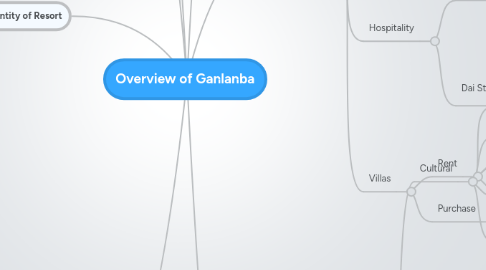
1. Current Population
1.1. Involvement
1.1.1. Shareholders
1.1.2. Lifestyle Change
1.1.3. Personal perspective / cultural authenticity
1.1.4. Land ownership
1.2. Management
1.2.1. Temporary jobs
1.2.2. Eviction living spaces
2. Policies
2.1. Gentrification
2.2. Limited development
2.2.1. No Cars
2.2.2. Neo-Urbanism
2.2.3. No new roads
2.2.3.1. Bring people by boat
2.3. Cultural Preservation
2.3.1. Authentic
2.3.2. Artificial "Authentic"
2.3.2.1. Relation to Chinese expectations
2.3.3. Limited Dai exposure
2.3.3.1. Phase 1.Very Limited
2.3.3.2. Phase 2. Partial
2.3.3.3. Phase 2. Complete
2.4. Tourism Policy
2.4.1. Promotion
2.4.1.1. Long-Term
2.4.1.2. "Soft"
2.4.1.3. $$$
2.4.2. Discouragement
2.4.2.1. Day-Tourism
2.4.2.2. "Cultural Pollution"
2.5. Gamification
2.6. Dai economic stimulation
2.6.1. Locally grown food for restaurants
3. Identity of Resort
3.1. Material
3.1.1. The DAI Token
3.1.1.1. Daixin
3.1.1.2. Peacock
3.1.1.2.1. Heimat des Peacocks
3.1.1.3. Sutras
3.1.1.4. * check präse of Investor
3.1.1.5. Bamboo Fireworks
3.1.2. Han goodies
3.1.2.1. Jade
3.1.2.2. Fruits
3.1.2.3. Spicy Food
3.1.2.4. Stamps
3.1.3. Architecture
3.2. Cultural
3.2.1. The Dai as part of China
3.2.2. The Dai as Thai people
3.3. Pragmatic
3.3.1. "Ease of access"
3.3.2. Affordability
4. Experience
4.1. Dai Culture as source
4.1.1. Hospitality
4.1.1.1. Food at host family
4.1.2. Village Culture
4.1.3. Rituals and Festivals
4.1.3.1. Closed-Door Festival
4.1.3.2. Village Gates
4.1.3.3. Daixin
4.1.3.4. Charms
4.1.4. Orchestrated experience
4.2. Modern Sources
4.2.1. Retail/Shopping
4.2.2. Cinemas/Theathers
4.2.2.1. * Open-Air Cinema
4.2.2.2. * Dai theater / Tai Theater
4.2.3. Cheap Thrills
4.3. Overall Concept
5. Infrastructure
5.1. Roads
5.1.1. Current
5.1.2. Future
5.1.3. Underground parking garage
5.2. Public Transportation
5.2.1. Tuk-Tuk
5.2.2. Trams
5.2.3. e-Bikes
5.3. Waterways
5.3.1. Sampans
5.3.2. Rafts
5.3.3. Speedboats
5.3.4. Ferrys
5.3.5. * Canals?
5.4. Public Infrastructure
5.4.1. Toilets
5.4.2. Food Stalls
6. Beds
6.1. Hotels
6.1.1. High-Rises
6.1.1.1. Capacities
6.1.1.2. Estimated Lifetime
6.1.1.3. Vertical Agriculture!
6.1.2. Deconstructibles
6.1.2.1. Re-Location capabilities
6.1.2.1.1. Involved Infrastructural Reformation
6.1.2.2. Price
6.1.2.3. Comfort
6.1.2.4. Value
6.1.2.4.1. Related to Dai Culture
6.1.2.4.2. Sustainability
6.2. Hospitality
6.2.1. Dai Houses (Old)
6.2.1.1. Models
6.2.1.1.1. Bed & Breakfast
6.2.1.1.2. Full Pension
6.2.1.1.3. Hostel
6.2.1.1.4. Only food
6.2.2. Dai Style Ho(s)tels
6.2.2.1. Functions
6.2.2.1.1. Hotels
6.2.2.1.2. Villas
6.2.2.1.3. Restaurants
6.3. Villas
6.3.1. Rent
6.3.1.1. Long-Term (Season, Year)
6.3.1.2. Short-Term (Week, Days)
6.3.2. Purchase
6.3.2.1. Gentrification!
7. Attractions
7.1. Cultural
7.1.1. Legends
7.1.2. Rituals
7.1.3. Festivals
7.1.4. Re-Enactments
7.1.5. The Morning + Evening Market
7.1.5.1. Barter
7.1.5.2. Morning & Evening
7.2. Geographical
7.2.1. Flora
7.2.1.1. Biodiversity
7.2.1.1.1. Info Spot
7.2.1.1.2. Edible plants
7.2.1.2. Botanical garden
7.2.1.2.1. Separate
7.2.1.2.2. "Garden City" Model
7.2.2. Fauna
7.2.2.1. Wild nature observation
7.2.2.1.1. "Tamed Elephants"
7.2.2.2. Tamed animals
7.2.2.2.1. Sacred Animals, beliefs
7.2.2.2.2. Cruel Animal show
7.2.2.2.3. Peacock
7.2.3. Landscape
7.2.3.1. Waterfront
7.2.3.1.1. Fishing
7.2.3.2. Hills
7.2.3.3. Bananna plantation
7.3. Material
7.3.1. Handicrafts
7.3.1.1. Bamboo vessels
7.3.1.2. Tea preparation techniques
7.3.1.3. Spices, cuisine
7.3.2. Architectural
7.3.2.1. Dai Architecture
7.3.2.2. Village Structure
7.3.2.3. Temples in Relation to village, expose
7.4. Artificial
7.4.1. Installations
7.4.1.1. Statues
7.4.1.2. Large-Scale Interventions
7.4.1.3. Unique Elements
7.4.2. Areas
7.4.2.1. Waterfront
7.4.2.2. Fishing ponds
7.4.2.3. Bananna plantations
7.4.2.4. Island
7.4.2.4.1. made from earth from the excavation of the underground parking
7.4.2.4.2. no-man's land
7.4.3. Facilities
7.4.3.1. "Real" Dai Village
7.4.3.2. Shipwrecks
7.4.3.3. Pull-Apart New Dai Architecture
7.4.3.3.1. Whole City as Attraction
7.4.3.3.2. District
7.4.3.3.3. 'LEGO' Style models
